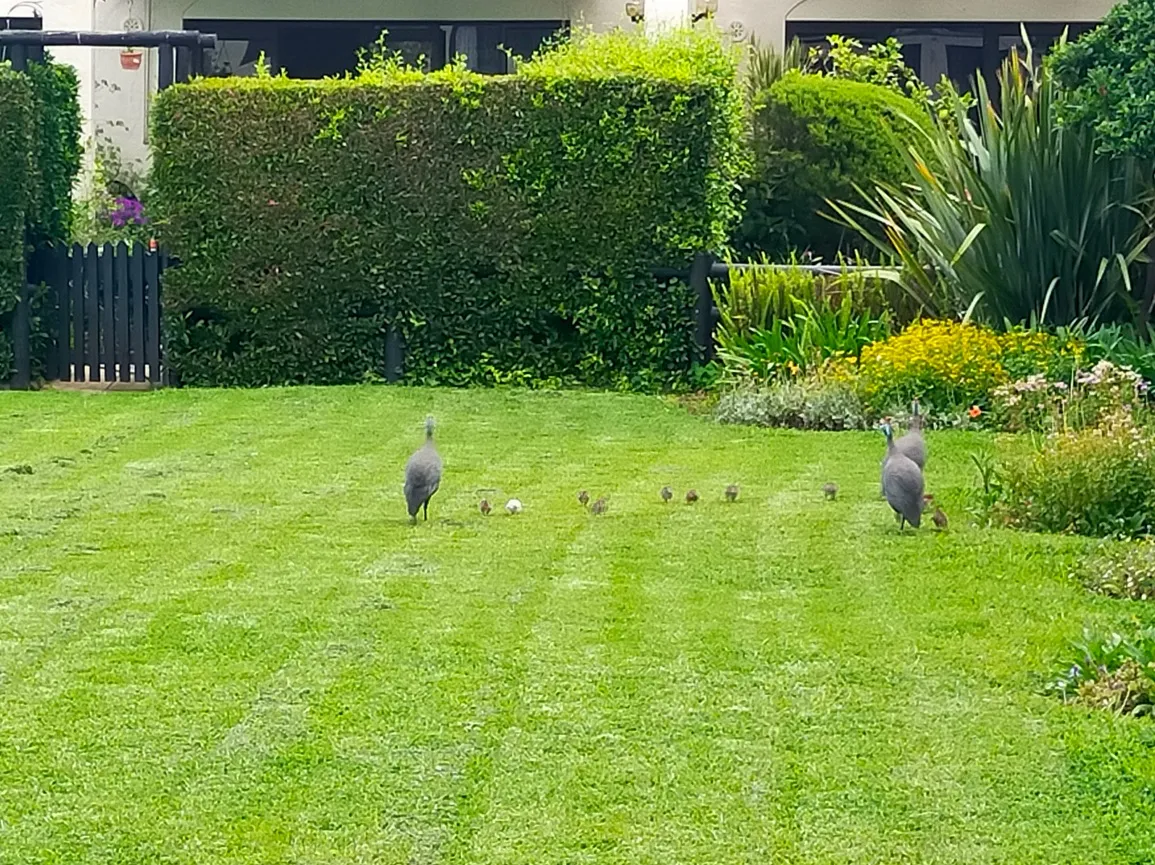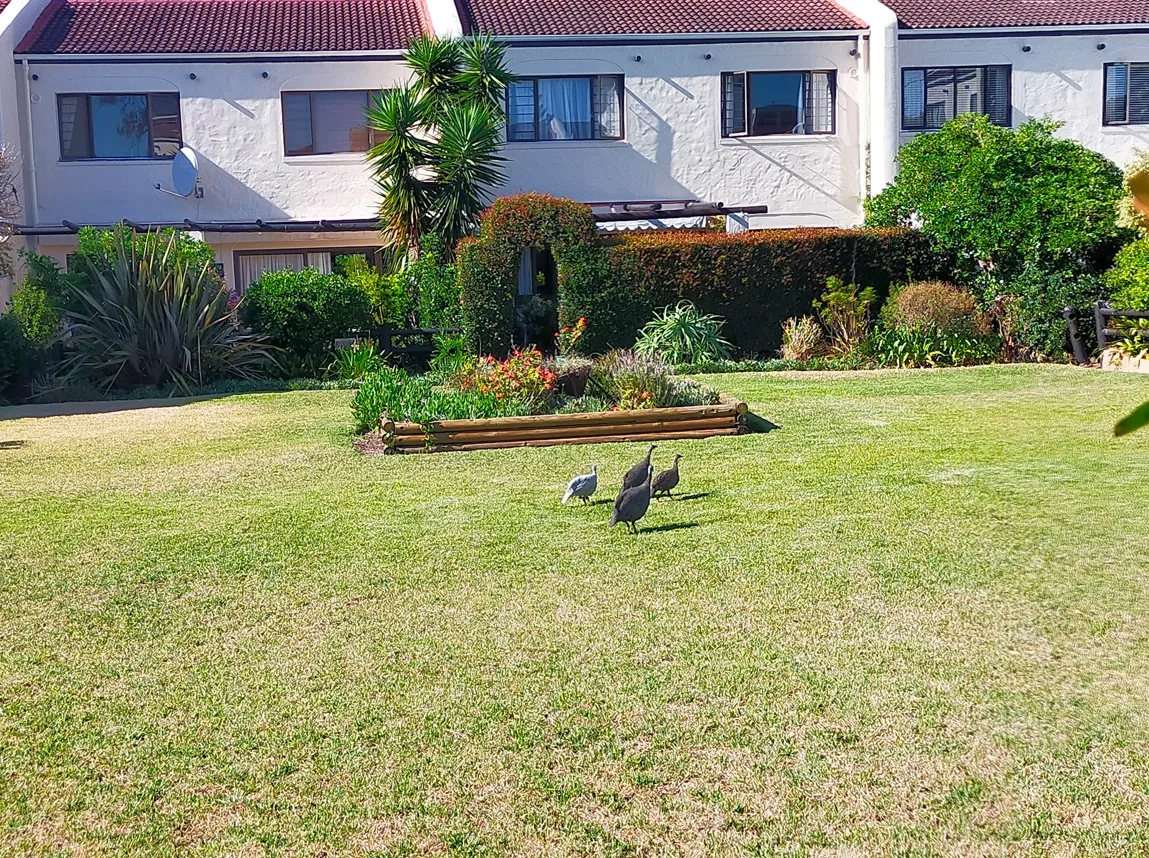Hello everybody! My name is Jasper and I'm writing to you from Cape Town in South Africa. Now, I usually post about music and surfing, but I thought I would pop in for a visit (my wife and I do love birdwatching when we get the chance), to tell you about a mystery I think I have solved!
A few months ago, we were planning on doing some gardening when my wife called me back and told me we had to postpone and go back inside. Why? The area under one of the bushes, in our tiny exclusive garden in our town-house complex, was being used by a helmeted guineafowl to shade her and her nest of eggs she was sitting on. We decided to leave her in peace until her babies hatched!
We then went away on a little holiday...

... and when we came back we found that the eggs had hatched successfully!

We looked around, and it wasn't long before we found the family in the main, communal garden in our complex!
Look carefully at the picture - one of the roughly ten new little babies, being looked after by the three adults, is a little WHITE puffball!
We assumed this was a baby with albinism. We also assumed that it was even less likely than its siblings to survive the gauntlet of cats and raptors in our area, and so we tried not to get to attached to "Whitey" the baby guineafowl. As hard as guineafowl try to be good parents (they are certainly better parents than Cape Spurfowl!), it is common for only a couple of babies to survive until adulthood. This little white baby was surely going to attract more predator attention than normal?

Surviving the odds!
Now it is months later. Three babies have survived so far into an advanced stage of "teenager", and I'm proud to report "Whitey" is one of them! Death by cat is now looking pretty unlikely, and there are newer babies in the area for raptors to prey on... I think "Whitey" is going to make it!
But we were a little confused... "Whitey" doesn't seem to have red eyes. The head seems to be grey? The characteristic spots of the adult helmeted guineafowl are there... just very faint on the white body... It seemed like "Whitey" didn't have albinism after all?
So what was going on? Luckily, in this modern day and age we have Google. This allowed us to learn about leucism, which is a slightly more common genetic mutation than albinism in birds. Where animals with albinism cannot produce melanin pigment at all, animals with leucism have reduced amounts of all sorts of pigment, but not to the extent that their eyes will be red or suffer poor vision.
The description of leucism seems to match our friend "Whitey" perfectly, so that is what we will assume! You can learn more about the differences between albinism and leucism here: https://www.treehugger.com/whats-the-difference-between-albino-and-leucistic-4864546
So! Have you ever seen animals with either albinism (there is a famous squirrel in a park in Cape Town CBD) or leucism? Do you have any photos?
(ESP)
¡Hola todos! Mi nombre es Jasper y les escribo desde Ciudad del Cabo en Sudáfrica. Ahora, normalmente publico sobre música y surf, pero pensé en visitarme (a mi esposa y a mí nos encanta observar aves cuando tenemos la oportunidad) para contarles sobre un misterio que creo haber resuelto.
Hace unos meses, estábamos planeando hacer algo de jardinería cuando mi esposa me llamó y me dijo que teníamos que posponerlo y volver a entrar. ¿Por qué? Debajo de uno de los arbustos de nuestro pequeño y exclusivo jardín en nuestro complejo de casas adosadas, una gallina de Guinea con casco estaba utilizando para darle sombra a ella y a su nido de huevos en el que estaba sentada. ¡Decidimos dejarla en paz hasta que sus bebés nacieran!
Luego nos fuimos de vacaciones...

... ¡y cuando regresamos descubrimos que los huevos habían eclosionado exitosamente!

Miramos a nuestro alrededor y no pasó mucho tiempo antes de que encontráramos a la familia en el jardín comunitario principal de nuestro complejo.
Mire atentamente la imagen: ¡uno de los aproximadamente diez nuevos bebés, que están siendo cuidados por los tres adultos, es un pequeño pedo BLANCO!
Supusimos que se trataba de un bebé con albinismo. También asumimos que era aún menos probable que sus hermanos sobrevivieran al desafío de los gatos y aves rapaces en nuestra área, por lo que tratamos de no encariñarnos con "Whitey", la cría de gallina de Guinea. Por más que las gallinas de guinea se esfuercen por ser buenos padres (¡sin duda son mejores padres que las aves de corral!), es común que sólo un par de crías sobrevivan hasta la edad adulta. ¿Este pequeño bebé blanco seguramente atraería más atención de lo normal de los depredadores?

¡Sobrevivir a las probabilidades!
Ahora han pasado meses. Tres bebés han sobrevivido hasta ahora en una etapa avanzada de "adolescente", y estoy orgulloso de informar que "Whitey" es uno de ellos. La muerte por gato ahora parece bastante improbable, y hay crías más nuevas en el área de las cuales las aves rapaces pueden aprovecharse... ¡Creo que "Whitey" lo logrará!
Pero estábamos un poco confundidos... "Whitey" no parece tener los ojos rojos. ¿La cabeza parece gris? Las manchas características de la gallina de guinea adulta con casco están ahí... sólo que son muy tenues en el cuerpo blanco... ¿Parecía que "Whitey" no tenía albinismo después de todo?
Entonces, ¿qué estaba pasando? Afortunadamente, en esta época moderna tenemos a Google. Esto nos permitió aprender sobre el leucismo, que es una mutación genética un poco más común que el albinismo en las aves. Mientras que los animales con albinismo no pueden producir ningún pigmento de melanina, los animales con leucismo tienen cantidades reducidas de todo tipo de pigmentos, pero no hasta el punto de que sus ojos se enrojezcan o sufran problemas de visión.
La descripción del leucismo parece coincidir perfectamente con nuestro amigo "Whitey", ¡así que eso es lo que asumiremos! Puede obtener más información sobre las diferencias entre albinismo y leucismo aquí: https://www.treehugger.com/whats-the-difference-between-albino-and-leucistic-4864546
¡Entonces! ¿Alguna vez has visto animales con albinismo (hay una ardilla famosa en un parque en Ciudad del Cabo CBD) o leucismo? ¿Tienes alguna foto?